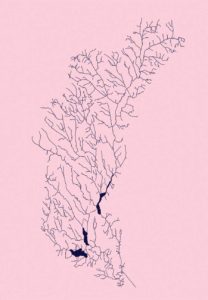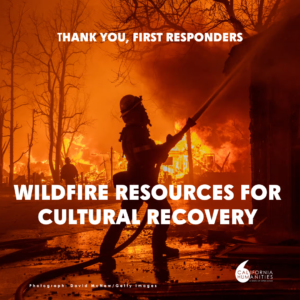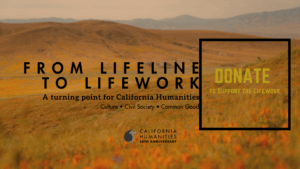FOREST⇌FIRE is a traveling interpretive exhibit with companion civic and educational engagement platforms that will help transform viewers’ cultural understanding about the Sierra Nevada forest, its relationship with fire, and their stewardship role within that relationship. Flowing thematically through past, present, and future, the exhibit includes multi-lingual (English, Spanish, Washo) didactic material and works of art in various mediums, including painting, textile, beadwork, sculpture, and photography. These mediums tell the story of how indigenous people, using low intensity fire, created and maintained the West’s pre-European, old-growth forest for thousands of years, why our forests are currently in ecological collapse, and what can be done immediately to prevent further losses.
In response to California’s recent wildfire crisis, we approached project directors Michael & Heather Llewellyn to inquire more about their project and its relation to the current events.
Please tell us about your experience working on this project – what have you done to date, what are you working on now, what is still in the works?
A disparate team of scientists, federal and state agencies, NGOs, land trusts, and politicians came together to develop the forest restoration prescription to stop the catastrophic fire in the Sierra Nevada forest. Our journey with FOREST⇌FIRE mirrors that effort on a community level. Beginning with the partners, Nevada County Arts Council, UC Berkeley’s Sagehen Creek Field Station, and Truckee Donner Recreation and Parks District, our project brings together a wide range of individuals and organizations to engage the general public in a cultural response to the restoration practices that will help the community save the forest and become resilient to climate change.
At present, 18 California writers and artists are producing work that will represent various aspects of the causes and consequences of a catastrophic fire in the Sierra Nevada and how we can respond. We are now preparing to frame our fellow artists’ work and finalize the floorplan layout for the exhibit.
Simultaneously, we are also writing the script for an animated short and editing the children’s book to support our future generations’ engagement platform. We will incorporate these materials into programming with the Truckee Tahoe Unified School District beginning in February 2021, and conducted by our additional partner, Sierra Watershed Education Partnerships.
Covid-19 delayed the roll-out of our civic-engagement platform this past spring. However, with support from the City of Truckee, the Washo Tribe of California and Nevada, the Tahoe National Forest, and the National Forest Foundation, artists and scientists will lead forest restoration field trips in spring 2021. Likewise, with support from libraries and the local historical society, we are developing a series of workshops that will offer community members an opportunity to respond to our forests’ changing nature through writing and artwork that will be included in the exhibit.
What has been the response from the community/communities you are engaging?
FOREST⇌FIRE would not be possible without the extraordinarily positive response and support from all sectors of our community, from education to finance, government, and science. All these organizations have been seeking a way to engage our community about the effects of climate change. FOREST⇌FIRE is an opportunity to focus their efforts collectively.
At this moment, California is experiencing the worst fire season in recorded history. Have recent events changed the way you are thinking about this project?
Our scientific partners warned us from the beginning that this fire season and more like it were inevitable. So, our thinking has not changed regarding the project, only our sense of urgency about bringing it to the public as soon as possible. The delays caused by Covid-19 were inconvenient, but the need to respond to this crisis has only grown larger.
How can the humanities help us understand complex issues (like the relationship between human activity and the environment)? From your perspective and experience, can the humanities make a difference in how people think and act?
As artists, our practice is to translate complex issues into means that the public can relate to. Story is how humans connect to the world around them. Telling stories is the gateway to understanding. Therefore, we chose to create an interpretive exhibit rather than an art exhibit. Art creates a visceral response, but story informs, inspires, and transforms culture. From our perspective, the humanities are crucial in helping communities process the challenges they face.
FOREST⇌FIRE debuts in October 2021 at the Truckee-Donner Recreation Center. The project is supported by the Nevada County Arts Council, Grass Valley, and a California Humanities for All Project Grant.







